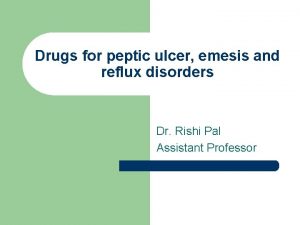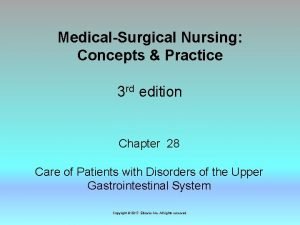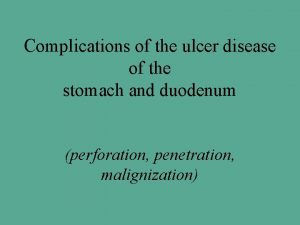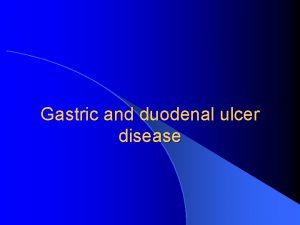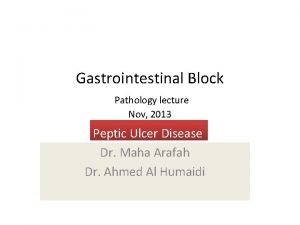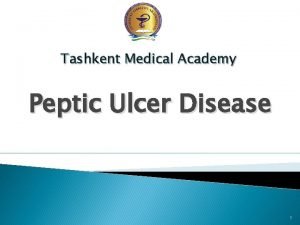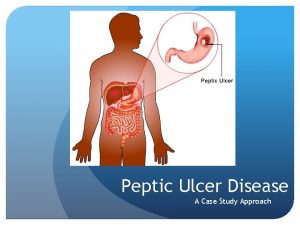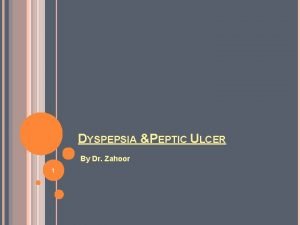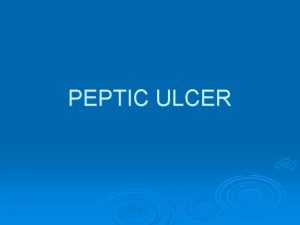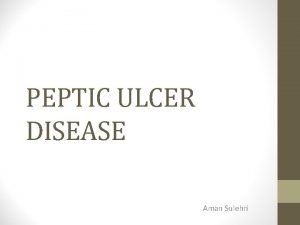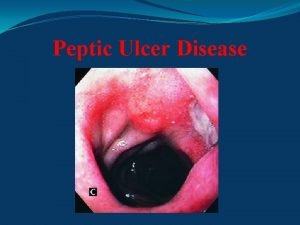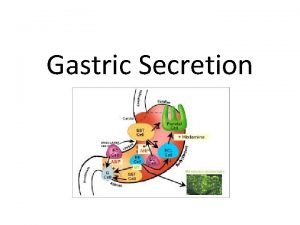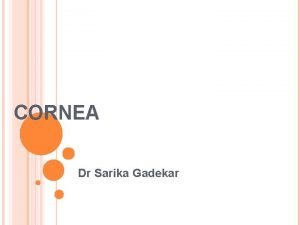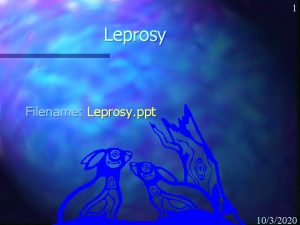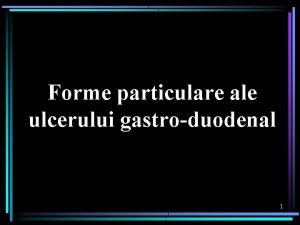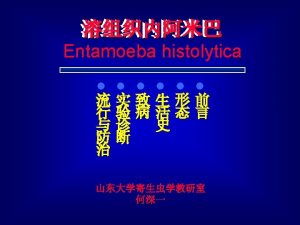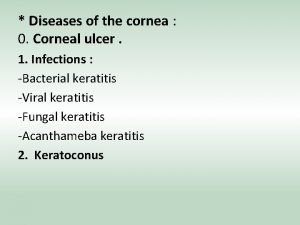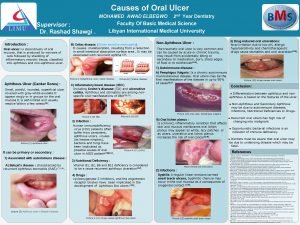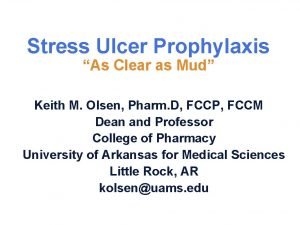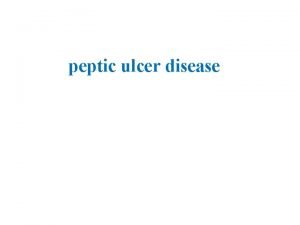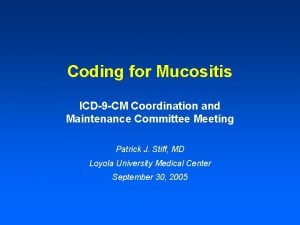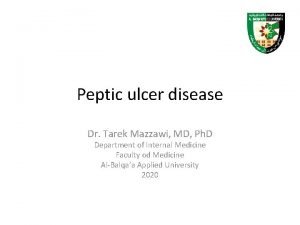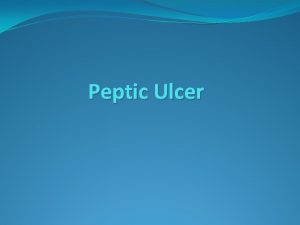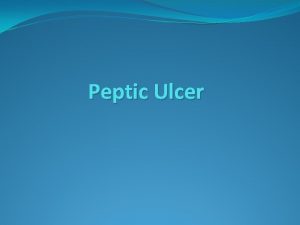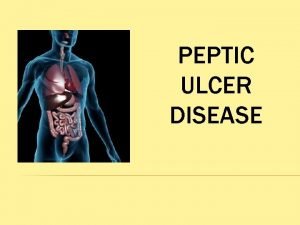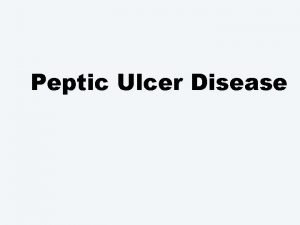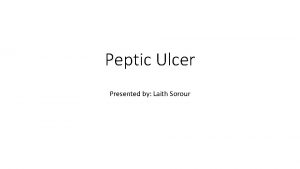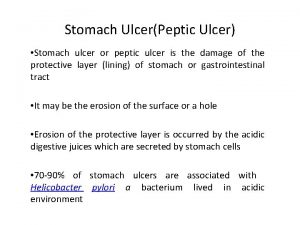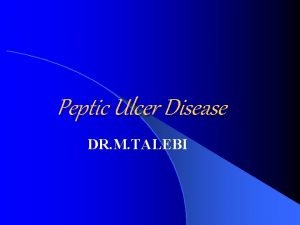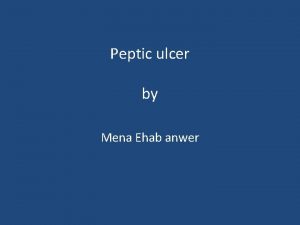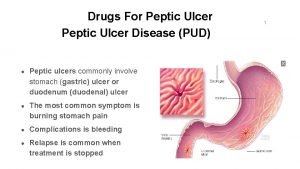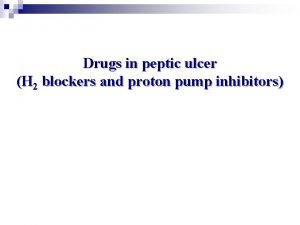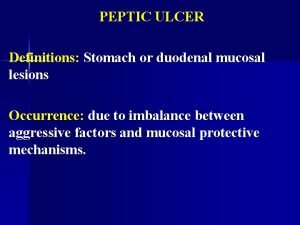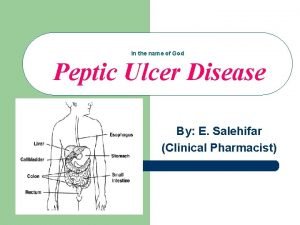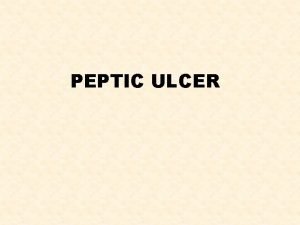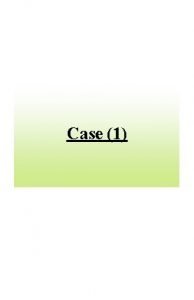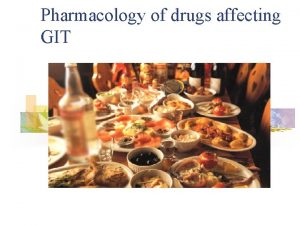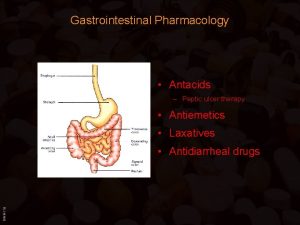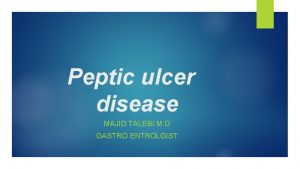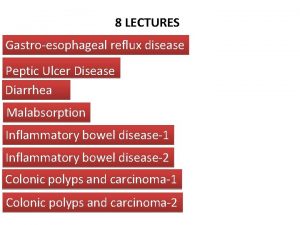What is peptic ulcer A peptic ulcer is





























- Slides: 29


What is peptic ulcer? �A peptic ulcer is an erosion of the mucosal lining of the stomach or duodenum. �Peptic ulcer disease (PUD) occurs when the mucosa is eroded to the point at which the epithelium is exposed to gastric acid and pepsin. �There are : �gastric ulcers, �duodenal ulcers �Esophageal ulcer, and � stress ulcers (these occur after major stress or trauma).

Causes of peptic ulcers �Helicobacter pylori infection (80 -95%) �Nonsteroidal anti-inflammatory drug (NSAID) use. �Severe stress (surgery, trauma, ICU) �Injury or death of mucosa producing cells �Hypersecretory states; hypercalcemia Genetics, blood group O


Diagnostic Procedures and Nursing Interventions �Helicobacter pylori testing: �Gastric samples are collected via an endoscopy to test for Helicobacter pylori. Several medications can interfere with testing for Helicobacter pylori (false negatives). �Urea breath testing is when the client exhales into a collection container (baseline), drinks carbon-enriched urea solution, and is asked to exhale once again into a collection container. The client should take nothing by mouth prior to the test. If Helicobacter pylori is present, the solution will break down and CO 2 will be released. �Ig. G serologic testing documents the presence of Helicobacter pylori based on antibody assays. �Stool sample tests for the presence of the Helicobacter pylori antigen.

Diagnostic Procedures and Nursing Interventions �Esophagogastroduodenoscopy (EGD) is the most definitive for diagnosis of peptic ulcers and may be repeated to evaluate treatment effectiveness. �Nsg responsibilities �Stool sample for occult blood (risk of PUD).


Assessment �Monitor for signs and symptoms of a peptic ulcer. �Dyspepsia – heartburn, bloating, and nausea. May be perceived as uncomfortable fullness or hunger. �Pain Gastric ulcer Duodenal ulcer 30 to 60 min after a meal 1. 5 to 3 hr after a meal Rarely occurs at night Often occurs at nigh Pain worsens with food ingestion Pain relieved by food ingestion



Assessment �Assess/monitor the client for: �Orthostatic changes in vital signs (20 mm Hg drop in systolic, 10 mm Hg drop in diastolic, and/or tachycardia; these findings are suggestive of gastrointestinal bleeding). �Nursing Diagnoses �Acute pain or chronic pain �Risk for deficient fluid volume �Disturbed sleep pattern � Anxiety related to coping with an acute disease � Imbalanced nutrition related to changes in diet �Deficient knowledge about preventing symptoms and managing the condition

Nursing Interventions �Administer prescribed medications. �Most commonly used is “triple therapy. ” This includes: �Bismuth or a Hyposecretory medication (proton pump inhibitors, histamine 2 antagonists, and prostaglandin analogues). �Two antibiotics to combat Helicobacter pylori: metronidazole (Flagyl) along tetracycline/ clarithromycin / amoxicillin. �Antacids are given 1 to 3 hr after meals to neutralize gastric acid, which occurs with food ingestion and at bedtime. Give 1 hr apart from other medications Sucralfate (Carafate) is given 1 hr before meals and at bedtime. Protects healing ulcers. Monitor for side effects of constipation.

Nursing Interventions �Assist the client with understanding/compliance with recommended dietary changes: �Avoiding/limiting substances that increase gastric acid secretion (caffeine, alcohol, and tobacco). �Avoiding foods that cause discomfort. �Smaller meals.

Complications and Nursing Implications �The nurse should perform periodic assessments of the client’s pain and vital signs (perforation or bleeding 0 �Perforation is severe epigastric pain spreading across the abdomen. The abdomen is rigid, board-like, hyperactive to diminished bowel sounds, and has rebound tenderness. �Perforation is a surgical emergency. �Gastrointestinal bleeding (? ? ? ? ? ) �The nurse should report findings, prepare the client for endoscopic or surgical intervention, replace fluid and blood losses, insert nasogastric tube, provide saline lavages, and maintain the client’s blood pressure. �Cancer

Constipation and Diarrhea

Definitions �Constipation is defined as bowel movements that are infrequent, hard or dry, and difficult to pass (painful, decrease in stool volume, or prolonged retention of stool in the rectum �Diarrhea is defined as an increased number of loose, liquid stools. It is usually associated with urgency, perianal discomfort, incontinence, or a combination of these factors. �There are objective ways to assess for the presence of constipation or diarrhea, but individual bowel patterns vary greatly. �For healthy clients, constipation and diarrhea are not serious. But for older adult clients or clients with pre-existing health problems, constipation or diarrhea can be serious.

Causes �Constipation: �Frequent use of laxatives. �Advanced age. �Inadequate fluid intake. �Inadequate fiber intake. �Immobilization due to injury. �A sedentary lifestyle. �certain medications; �rectal or anal disorders; �obstruction; �metabolic, neurologic, and neuromuscular conditions; �endocrine disorders; �lead poisoning;

Causes �Diarrhea: �Viral gastroenteritis. �Overuse of laxatives. �Use of certain antibiotics. �Inflammatory bowel disease. �Irritable bowel syndrome. �Food-borne pathogens.

Diagnostic Procedures and Nursing Interventions �Fecal occult blood test. Certain foods (red meat, raw vegetables) and medications (aspirin, NSAIDs) can cause false positives. �Bleeding can be a sign of cancer, which can be a contributing factor to constipation. �Digital rectal exam checks for impaction, (left side with knees flexed). During the procedure the client’s vital signs and response should be monitored. �Obtaining stool cultures �barium enema � sigmoidoscopy

Assessment �Monitor for signs and symptoms of constipation. �Abdominal bloating �Abdominal cramping �Straining at defecation �Decreased appetite, headache, fatigue, indigestion, sensation of incomplete emptying �Monitor for signs and symptoms of diarrhea. �Signs and symptoms of dehydration �Frequent loose stools �Abdominal cramping

Assessment �Other symptoms, depending on the cause and severity and related to dehydration and fluid and electrolyte imbalances: �Watery stools, which may indicate small bowel disease �Loose, semisolid stools, which are associated with disorders of the large bowel �Voluminous greasy stools, which suggest intestinal malabsorption �Blood, mucus, and pus in the stools, which denote inflammatory enteritis or colitis �Oil droplets on the toilet water, which are diagnostic of pancreatic insufficiency �Nocturnal diarrhea, which may be a manifestation of diabetic neuropathy

Nursing assessments should include �A physical examination of the abdomen (bowel sounds and tenderness). �Assessment for signs and symptoms of fluid deficit. �Assessment of the skin integrity around the anal area. �Collection of a detailed history of the client’s diet, exercise, and bowel habits.

NANDA Nursing Diagnoses �Constipation �Diarrhea �Fluid volume deficit �Impaired skin integrity

Nursing Interventions �Closely monitor the client’s fluid status. Maintain a strict record of I&O. �Monitor the client for S&Sx of dehydration (postural hypotension, dizziness when changing positions). �Closely monitor the client’s elimination pattern. �Observe and document the character of the client’s bowel movements. �Carefully check for blood or pus. If the client is experiencing diarrhea, measure the volume of the stools. �Perform an abdominal assessment daily and as needed.

Nursing Interventions �Administer laxatives and/or enemas as prescribed. �Encourage the client to engage in adequate fluid intake (especially water intake), adequate fiber intake, and exercise within reason. �Monitor the client’s skin integrity. �Suggest that clients who are taking antibiotics eat yogurt to help re-establish an intestinal balance of beneficial bacteria.

Nursing Management for diarrhea �Complete health Hx to identify character and pattern of diarrhea, and: �Related signs and symptoms, �current medication therapy, � daily dietary patterns and intake, � past related medical and surgical history, and � recent exposure to an acute illness or travel to another geographic area. � • Perform a complete physical assessment, paying special attention to auscultation (characteristic bowel sounds), palpation for abdominal tenderness, inspection of stool (obtain a sample for testing). � • Inspect mucous membranes and skin to determine hydration status, and assess perianal area.

Nursing Management for diarrhea � • Encourage bed rest, liquids, and foods low in bulk until acute period subsides. � • Recommend bland diet (semisolids to solids) when food intake is tolerated. � • Encourage patient to limit intake of caffeine and carbonated beverages, and avoid very hot and cold foods because these increase intestinal motility. � • Advise patient to restrict intake of milk products, fat, whole grain products, fresh fruits, and vegetables for several days. � • Administer antidiarrheal drugs as prescribed. � • Monitor serum electrolyte levels closely.

Complications of constipation �Fecal impaction. �Development of hemorrhoids or rectal fissure. �Bradycardia, hypotension, and syncope associated with the Valsalva maneuver (occurs with straining/bearing down). �Monitoring constipation carefully. Instruct clients not to strain to have bowel movements. Take measures to effectively treat and prevent constipation. �Removing a fecal impaction

Complications of diarrhea �Signs and symptoms of dehydration and fluid and electrolyte disturbances (metabolic acidosis). �Skin breakdown around the anal area. �Replace losses as prescribed. Monitor the client’s skin breakdown carefully and follow skin care protocols
 Peptic ulcer disease
Peptic ulcer disease Objectives of peptic ulcer
Objectives of peptic ulcer Acholorhydria
Acholorhydria Patient counselling for peptic ulcer disease
Patient counselling for peptic ulcer disease Stages of peptic ulcer perforation
Stages of peptic ulcer perforation Polya gastrectomy vs billroth 2
Polya gastrectomy vs billroth 2 Arsas symptoms
Arsas symptoms Peptic ulcer morphology
Peptic ulcer morphology Peptic ulcer classification
Peptic ulcer classification Proton pump inhibitor
Proton pump inhibitor Triple therapy for peptic ulcer disease
Triple therapy for peptic ulcer disease Peptic ulcer disease
Peptic ulcer disease Anatomy and physiology of gastritis
Anatomy and physiology of gastritis Peptic ulcer diseas
Peptic ulcer diseas Peptic ulcer causes
Peptic ulcer causes Trifoliate duodenum meaning
Trifoliate duodenum meaning Typhoid ulcer vs tuberculous ulcer
Typhoid ulcer vs tuberculous ulcer Niche and notch in gastric ulcer
Niche and notch in gastric ulcer Duodenal ulcer vs gastric ulcer
Duodenal ulcer vs gastric ulcer The composition of gastric juice
The composition of gastric juice Ectatic cicatrix
Ectatic cicatrix Leprosy ppt 2020
Leprosy ppt 2020 Ulcer bulbar definitie
Ulcer bulbar definitie Amebiasis
Amebiasis Dendritic keratitis
Dendritic keratitis Oral ulcer
Oral ulcer H2ra vs ppi
H2ra vs ppi Asge
Asge Icd 9 code for aphthous ulcer
Icd 9 code for aphthous ulcer Ulcer stool
Ulcer stool
